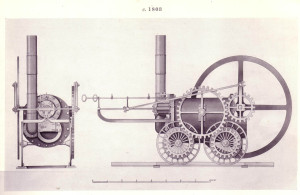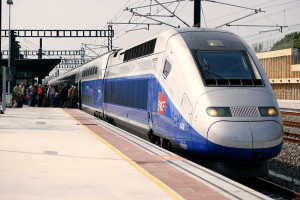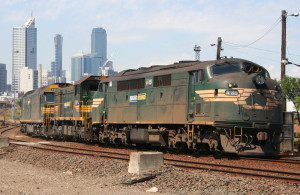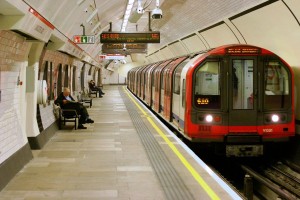Here are some facts about trains.
- A train is made up of carriages (also known as wagons or cars) pulled by an engine (or locomotive). A steam engine also pulls a tender (a wagon containing fuel).
- Steam trains were first built (in the early 1800s) to carry goods and materials, but they soon were used to transport passengers, too.
- Diesel trains started to replace steam trains in the middle of the 20th century.
- The fastest trains in the world are powered by electricity. The electricity is transmitted to the train, either by overhead cables or through special rails running alongside the track.
Steam Engine Facts

- The first ever steam train was built by Richard Trevithick in 1804. This train was too heavy and broke the track, so Trevithick built a new engine, called Catch Me Who Can. This was lighter and worked well on a circular track.
- In 1825, George Stephenson opened a railway in the north of England. He designed a steam train called Locomotion, and used it to pull wagons full of coal.
- George Stephenson’s most famous steam engine was called the The Rocket was both fast (for 1829) and reliable.
- From the 1830s, railways started to spread throughout the world. To begin with, British built trains were used in foreign countries, but then countries like France and Germany started to manufacture their own steam locomotives.
- The first steam locomotive to be run in Germany was called Der Adler.
- Many individuals made lots of money in the railway industry. George Hudson, and English businessman, for example, was known as the ‘Railway King’.
- The oldest working steam locomotive is in India. The Fairy Queenwas built in Britain in 1855 and shipped to India. It still runs today.
- Steam locomotives have three types of wheel. The largest wheels are known as the ‘driving wheels’. These are turned by pistons and make the locomotive move. Small wheels at the front are called ‘leading wheels’. These help to guide the engine forward. Small wheels at the back of the locomotive are called trailing wheels, and these help to support the weight of the firebox and driver’s cab.
- In America, railways are called railroads. Railroads were first built in the United States in the 1930s.
- The Union Pacific Railroad opened in 1869, and ran all over the USA, crossing North America.
- The first passenger trains had three classes of carriage. First class carriages had many windows and were beautifully decorated and furnished. Second class carriages were designed in much more simple fashion. They had fewer windows than the first class carriages. Third class carriages were very rough and ready. They weren’t decorated at all, and, before 1840, they didn’t even have the have a roof.
- The very richest travellers really did travel in luxury in the 19th century. Queen Victoria’s coaches had walls padded with silk, and Emperor Napoleon III of France had a private train with a balcony and an extensive wine collection.
- Steam trains were also used in city railways, but it soon became apparent that they weren’t ideally suited for this purpose – the locomotive’s smoke covered everything in soot. Electrically-powered trains started to be introduced in cities as an alternative to steam in the 1880s.
- One of the world’s fastest steam locomotives was called The Flying Scotsman. It was built in Britain and went non-stop between London and Edinburgh. In 1934 it becomes the first locomotive to travel faster than 100 mph.
- In 1938, the Mallardset a new steam locomotive speed record when it hit 138 mph in 1938.
- The largest steam engines were built in the 1940s. The Union Pacific Big Boy locomotives, for example, were massive and could haul 100 full wagons, reaching speeds of 70 mph.
- Steam trains are still used in some parts of the world. China, for example, still uses steam locomotives, but no new Chinese steam trains have been designed since 1982.
- In Europe and the US, groups of steam enthusiasts restore and run steam locomotives, ensuring that steam trains will never disappear completely. Some lines run steam locomotives purely for the tourist industry.
Electric Train Facts
 High-speed electric trains started to be used in the 1950s for long distance passenger journeys.
High-speed electric trains started to be used in the 1950s for long distance passenger journeys.- The earliest high-speed electric trains were designed in Europe (such as Italy’s Settebello). They could reach speeds of 80 mph, but they often had to slow down because they were sharing tracks with slower moving passenger and freight trains.
- In 1964 the Japanese opened a purpose built high-speed electric train line, running between Osaka and Tokyo. The ‘bullet trains’ could travel at speeds of 130 mph.
- In France in 1982, Parisand Lyon were linked by a line using TGV trains. These electric trains had an average speed of 168 mph.
- Modern TGV trains have a top speed of 186 mph.
Diesel Train Facts
 From the 1930s, diesel locomotives started to replace steam engines. They were cheaper and faster.
From the 1930s, diesel locomotives started to replace steam engines. They were cheaper and faster.- In 1957, the high-speed diesel Trans-Europe Express linked the Netherlands, Switzerland, Italy, France and Germany. The Trans-Europe Express trains were red and were fitted out to a luxury standard.
- Diesel powered engines were introduced in Britain in the 1960s. The early designs of British diesels were called Deltics.
- Freight trains are hauled by diesel locomotives. The longest freight train ever had 660 wagons and was pulled by 16 diesel engines.
Underground Train Facts
 The London Underground railway opened in 1863. Its first line was called the Metropolitan Railway. It was 4 miles in length and was originally used by steam engines. These were replaced by electric trains when people decided steam engines were too smoky for use in tunnels.
The London Underground railway opened in 1863. Its first line was called the Metropolitan Railway. It was 4 miles in length and was originally used by steam engines. These were replaced by electric trains when people decided steam engines were too smoky for use in tunnels.- By 1900 underground railways also existed in Boston, Paris and Budapest. The Moscow Metro, with its ornate stations, was built in 1930
- The Paris Metro opened in 1900. It now has more than 300 stations, many of which have entrances designed by Hector Guimard in the Art Noveau style.
Other Train Facts
- Some of the highest railways in the world are in the Andes mountain range in South America. The Peruvian Central line climbs so high that it carries bottled oxygen in case passengers experience breathing difficulties due to the high altitude.
- Model trains have been in existence for almost as long as real trains. One of the largest model railway layouts was made by Bruce Williams Zaccagino. It included 8 miles of track, incorporated more than 250 bridges, and included thousands of buildings and half a million trees.
Source: https://primaryfacts.com/4645/train-facts-for-kids/




















